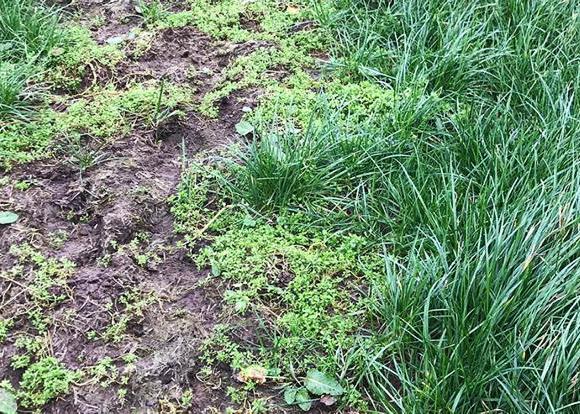Just over a year ago I tried my hand at multispecies swards (MSS).
At the time I was very sceptical, but very intrigued. I really wanted to see how they would perform under more challenging conditions further west, as they did seem to be doing very well for those farming dry land.
To be honest I was a bit naive, and it was exceedingly difficult to get good advice suited to here. I decided that the best thing to do was trial and error, and learn for myself what might work.
Establishment was actually particularly good and it looked a lot better than I thought it would. I got several grazings before the winter, and all seemed fine.
In the spring I put on a coat of slurry with a dribble bar, and I lulled myself into a false sense of security. What followed was an extremely poor spring/early summer, and it took its toll on the MSS.
I tried to manage it in the same way that I manage my perennial ryegrass swards. Eating it off tight in the spring and back in to graze after three weeks. With the severe weather, this had a devastating effect on the plantain and chicory within the mix.
At the start of June, I was ready to pack in this experiment and write it off as a disaster. I pulled the cattle off it in disgust.
Farm walk
Around the same time, there was a farm walk hosted by Paul Turley in Downpatrick to highlight his experiences with MSS.
I decided to go along and have a look at what he was doing, although in the back of my mind I thought it would be a waste of time as he is working under near drought conditions and nothing like the west.
I did try to get some of my farming friends to tag along but none were particularly interested. But given it was that long since I had the opportunity to go to a farm walk, I was determined to go in any event
I went and it was an eye-opening experience. We got an open and frank assessment from Paul about his experience. He was honest about what worked and what didn’t.
While my conditions are totally different, I learned one big lesson – you cannot manage your MSS in the same way as perennial ryegrass swards.
You need to be going in at higher covers and coming out with some left behind. You also need a longer rotation (30 days, not the normal 21 days).
Recovery
I took my new-found knowledge home and changed my MSS management. It was actually remarkably successful, and my MSS made a particularly good recovery. It would be still lacking in chicory but not bad considering where it was at the beginning of June.
I have now decided to do some more and to establish a bigger block so that I can keep one group of cattle on it for the entire year. It should mean that group are settled on the sward, and I will also be able to see if there are any anthelmintic properties (one of the benefits claimed for MSS).
Direct drill
However, rather than ploughing ahead of establishment, this time I decided to direct drill it in. I had added ground lime at the end of last year to push the pH closer to 6.5. I gradually sprayed the area off with roundup as I grazed the paddocks out, and got a contractor to drill the seed in.
This meant some of the paddocks were sprayed off about ten days and some just before being seeded. I also added some G-lime just to compensate for any negative affect from the dying vegetation.
I normally like to go with a full plough reseed, but I decided to try something new this time.
It is early days but it would seem that it takes a little longer for the seed to germinate. I’m not sure if this is because the seed is buried a little deeper or maybe there isn’t as much soil contact.
Anyway, I have now got my second field of MSS (or weeds as some of my friends call it). Hopefully, I am in a better position to manage the new MSS this time around.
I’m still not convinced that it will work under challenging conditions, but I am going to give it a second chance. If I can get it to work then there are potentially a lot of wins for me and for the environment. One way or the other I will share my journey.
Read more
Mindset change with multispecies swards
Watch - Farmer Writes: less silage made than I would like
Just over a year ago I tried my hand at multispecies swards (MSS).
At the time I was very sceptical, but very intrigued. I really wanted to see how they would perform under more challenging conditions further west, as they did seem to be doing very well for those farming dry land.
To be honest I was a bit naive, and it was exceedingly difficult to get good advice suited to here. I decided that the best thing to do was trial and error, and learn for myself what might work.
Establishment was actually particularly good and it looked a lot better than I thought it would. I got several grazings before the winter, and all seemed fine.
In the spring I put on a coat of slurry with a dribble bar, and I lulled myself into a false sense of security. What followed was an extremely poor spring/early summer, and it took its toll on the MSS.
I tried to manage it in the same way that I manage my perennial ryegrass swards. Eating it off tight in the spring and back in to graze after three weeks. With the severe weather, this had a devastating effect on the plantain and chicory within the mix.
At the start of June, I was ready to pack in this experiment and write it off as a disaster. I pulled the cattle off it in disgust.
Farm walk
Around the same time, there was a farm walk hosted by Paul Turley in Downpatrick to highlight his experiences with MSS.
I decided to go along and have a look at what he was doing, although in the back of my mind I thought it would be a waste of time as he is working under near drought conditions and nothing like the west.
I did try to get some of my farming friends to tag along but none were particularly interested. But given it was that long since I had the opportunity to go to a farm walk, I was determined to go in any event
I went and it was an eye-opening experience. We got an open and frank assessment from Paul about his experience. He was honest about what worked and what didn’t.
While my conditions are totally different, I learned one big lesson – you cannot manage your MSS in the same way as perennial ryegrass swards.
You need to be going in at higher covers and coming out with some left behind. You also need a longer rotation (30 days, not the normal 21 days).
Recovery
I took my new-found knowledge home and changed my MSS management. It was actually remarkably successful, and my MSS made a particularly good recovery. It would be still lacking in chicory but not bad considering where it was at the beginning of June.
I have now decided to do some more and to establish a bigger block so that I can keep one group of cattle on it for the entire year. It should mean that group are settled on the sward, and I will also be able to see if there are any anthelmintic properties (one of the benefits claimed for MSS).
Direct drill
However, rather than ploughing ahead of establishment, this time I decided to direct drill it in. I had added ground lime at the end of last year to push the pH closer to 6.5. I gradually sprayed the area off with roundup as I grazed the paddocks out, and got a contractor to drill the seed in.
This meant some of the paddocks were sprayed off about ten days and some just before being seeded. I also added some G-lime just to compensate for any negative affect from the dying vegetation.
I normally like to go with a full plough reseed, but I decided to try something new this time.
It is early days but it would seem that it takes a little longer for the seed to germinate. I’m not sure if this is because the seed is buried a little deeper or maybe there isn’t as much soil contact.
Anyway, I have now got my second field of MSS (or weeds as some of my friends call it). Hopefully, I am in a better position to manage the new MSS this time around.
I’m still not convinced that it will work under challenging conditions, but I am going to give it a second chance. If I can get it to work then there are potentially a lot of wins for me and for the environment. One way or the other I will share my journey.
Read more
Mindset change with multispecies swards
Watch - Farmer Writes: less silage made than I would like










SHARING OPTIONS